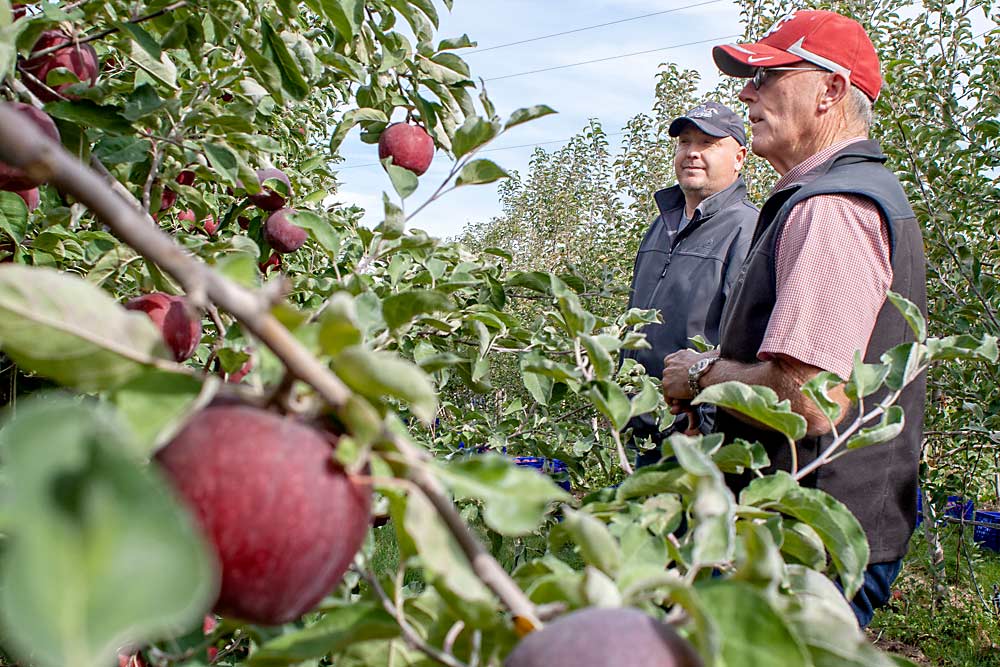
As we approach the first commercial harvest this fall of WA 38, the new Washington State University-bred apple variety to be sold under the brand name Cosmic Crisp, we may want to revisit some of the horticultural traits we’ve learned about — both in the breeding program and in commercial plots, so far.
Much has been written and discussed about WA 38 being a type four tree and having blind wood issues. However, the breeding program plots have had trees that exceed 100 bins per acre without blind wood management techniques being employed.
Granny Smith can have yields approaching 150 bins per acre with no blind wood management. WA 38, of course, needs more light to achieve good fruit color, so yields may be less than with Granny Smith.
Vigor management is important. Very high vigor that generates shoot calipers bigger than a half-inch, or 13 millimeters, will aggravate blind wood traits. The key to reducing vigor over time: fruit.
With a type four variety, tipping shoots will reduce the crop. If cropping is delayed, vigor and shoot caliper can become antagonistic to fruit set and yield efficiency.

With that said, here are a few tree management suggestions from what I’ve seen in the breeding program and in commercial plots, so far:
Feathered trees from the nursery should have the feathers shortened back to viable buds, preferably to a bud on the bottom of the shoot. Most nursery feathers will not have good bud break.
Gala, Fuji and Honeycrisp have all shown blind wood tendencies from the nursery. WA 38 responds very well to scoring with a fine saw/knife or light girdling using double-bladed hand clippers.
The typical goal for a newly planted orchard is to fully develop the fruiting canopy as quickly as possible. WA 38 is no different. Granny Smith has the most similar growth habit to WA 38.
Mildew control is pretty important to keep vigor high and reduce the number of blind buds on one-year wood.
Fruit set is not heavy. About half of the flowering clusters do not set, therefore WA 38 may need twice as many flowering sites as Fuji or Honeycrisp to obtain target yields. Chemical thinning may need to wait until the third or fourth crop. Hand thinning should wait until well after June drops are complete.
Strong shoots should be cut by 12 to 15 leaves to reduce caliper development, usually in June. Summer pruning of shoots is effective into July.
Current season growth and/or horizontal feathers, if allowed to be longer than 12 inches, will be pretty blind for two or three seasons. Cutting strong shoots at 10 to 15 leaves may develop some fruiting spurs.
Dormant pruning of vigorous second-leaf trees should be limited to manage competing shoots to the leader and the strong growth in the bottom of the tree. Strong shoots should be brought back to the very small buds visible at the base of the shoot.
Heading in the middle of pencil-size and larger shoots can incite an angry tree response. Bourse shoots and fine one-year shoots should not be tipped.
Tipping small wood in moderate vigor trees can generate flower clusters when done in June. This wood should not be tipped/headed in the dormant season. In general, 50 percent of the crop will come on the small, untipped/headed one-year wood.
A lot of tipping will dramatically reduce crop potential, reducing the most effective vigor control: fruit.
Third leaf and later, there should be no heading or tipping in the dormant season. Tipping the very strongest shoots in June can be helpful.
Growers should focus on renewal pruning and removing large-caliper/blind wood branches, which will require leaving stubs. Avoid shortening any shoots until good spur development is very evident.
As vigor increases, the number of cuts per tree must be reduced. More cuts will create more vigor.
It will be important to manage the number of pruning cuts when shoot growth exceeds 18 inches around the perimeter and more than 2 feet vertically. A tactic in very vigorous trees would be to count the 1-inch and larger limbs in the tree and divide by three.
For example, if there are 12 limbs 1-inch and larger, four of the 12 need to be removed. Growers should give priority to removing large limbs growing into the drive row and from the top down.
It may seem that some of these suggestions are inconsistent, but the reality is that there is not one growing region or tree vigor.
The timing of pruning makes a big difference, as tipping wood in June can reduce the development of large-caliper wood. Pruning wildly vigorous trees from pink to first green fruit drop (8 millimeters) can minimize the antagonistic increase in vigor that pruning can induce.
This is also a good time to complete trunk girdling or root pruning. The low-vigor, high-elevation sites in older growing regions may need to increase vigor and not be aggressive at developing cropping.
In other locations, controlling vigor and encouraging fruiting is very important. There must be a very different emphasis on cultural practices to accommodate the growing site with the same scion variety.
The industry has developed Gala, Granny, Honeycrisp and Fuji into high-yielding new orchards in a short time. WA 38 falls in the Granny/Fuji range of growth habit.
The biggest difference is fruit set, where Gala, Honeycrisp and Fuji can set heavy and need some attention to bloom counts, pruning and crop load management to reduce overcropping and severe biennial bearing.
WA 38 will need more fruiting sites and restraint in crop load management until each site’s managers understand the cropping and thinning habits of the variety in their particular sites.
Several years ago, former U.S. Department of Agriculture researcher Don Heinicke, also an Orondo, Washington, grower, shared the term “AGR,” or Alert Grower Response. Be alert to the growth and caliper of one-year wood, be responsive to the vigor of the tree and prune to reduce big caliper, long shoots.
Too low of vigor (shoot growth less than 4 inches) appears to be a trigger for biennial bearing in WA 38.
The good news: WA 38 does not need vast amounts of tree training or manipulation. It is not prone to overset, as Fuji and Honeycrisp often do. It does not have storage issues that suppress packouts over time. It is a tremendously stable product going to market and to the consumer’s table.
WA 38 is not a mystery or hard-to-master variety for Washington growers. •
— by Tom Auvil
Tom Auvil is a longtime horticulturist, formerly with the Washington Tree Fruit Research Commission and now with North American Plants, who continues to play a role in tracking and preparing for the WA 38 rollout.






Leave A Comment